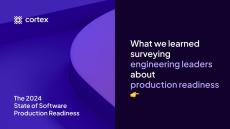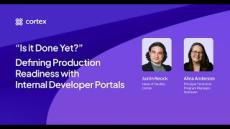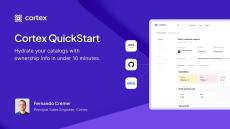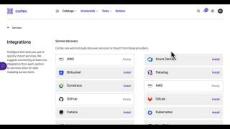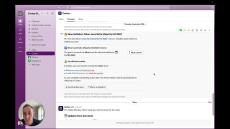|
By Cortex
Learn how to measure and improve developer productivity with actionable tips, key metrics, and strategies for long-term success in software development.
|
By Lou Bichard
Following up on his discussion at IDPCON, Lou Bichard, Product Manager at Gitpod, revisits the topic of the developer inner loop. Lou Bichard|
|
By Cortex
Learn what SLOs are, how to set them effectively, best practices, and key metrics for optimal service reliability. Cortex|
|
By Cortex
Learn how to migrate from on-prem to the cloud with ease. Explore benefits, strategies, steps, and best practices for a seamless transition. Cortex|
|
By Cortex
Learn how to identify, map, and manage dependencies in dynamic systems to reduce downtime, speed up troubleshooting, and streamline development workflows. Cortex|
|
By Cortex
Learn how to measure, implement, and improve SPACE metrics in DevOps. Get actionable tips and overcome common challenges in team performance tracking. Cortex| January 2, 2025 Software development team performance.
|
By Cortex
Learn what lift and shift migration is, its benefits, use cases, and how to execute it successfully with actionable tips and best practices.
|
By Cortex
As the year draws to a close, it’s the perfect time to reflect on achievements and set sights on what could make the next year even better. For engineering teams, this season is an opportunity to dream of the tools, practices, and culture shifts that drive engineering excellence in the year to come. Cortex|
|
By Cortex
Is developer portal a misnomer? Learn how all roles and teams in engineering are making use of IDPs. Cortex|
|
By Cortex
Learn how CI/CD tools are enhanced with IDPs—to speed deployments, and increase consistency in software development. Cortex|
|
By Cortex
The industry is still asking more questions than its answering around #DevEx, Platform Engineering, and even (still!) #DevOps! Hear from Cortex's very own Head of Developer Relations, Justin Reock, get together and talk with other interested minds helps move us more collectively to answers and solutions that can improve the flow, productivity, and ultimately joy of our workforce! Full description.
|
By Cortex
98% of engineering leaders reported at least one major consequence of failing to meet production readiness standards. To better understand how teams are addressing new challenges in production readiness, Cortex recently conducted a survey of engineering leaders at companies with more than 500 employees in North America, Europe, and AsiaPac. The survey included questions pertaining to production readiness standards, tools, struggles, and desired future state.
|
By Cortex
DevOps solutions have evolved quickly over the last few years. Software catalogs have bloomed beyond service registries and runbooks into comprehensive, centralized engineering sources of truth. With ever-expanding developer tool sets, can teams achieve the flexibility needed to address this fragmentation while continuing to tailor software catalog entries to their unique domains and contexts?
|
By Cortex
While we know software projects are never truly “done,” developers will, nevertheless, often face a long list of tasks needed to achieve a certain level of “doneness.” But to what end? And when do they end? When is done—done enough? In this fireside chat-style webinar, Justin Reock - Head of DevRel for Cortex - alongside Alina Anderson - Principal Technical Program Manager at Outreach - will explore an evolved approach to determining production readiness.
|
By Cortex
Lauren Craigie (Head of PMM at Cortex) is joined by Justin Reock, Head of Developer Relations at Cortex for a conversation about meausuring developer productivity.
|
By Cortex
In 2023 most engineering organizations have some way of measuring productivity. Metrics like story points and cycle time help us assess team-wide impact, while code coverage and commits tell us more about individual contributions. While we know these numbers don’t tell the whole story, we rarely hear about how to find the missing pieces. Or what to do next when we learn the culprit is poor testing practices versus bad design. What’s the plan for improvement? Where does it live, and who owns it?
- January 2025 (7)
- December 2024 (5)
- November 2024 (4)
- October 2024 (5)
- September 2024 (9)
- August 2024 (6)
- July 2024 (6)
- June 2024 (6)
- May 2024 (7)
- April 2024 (7)
- March 2024 (8)
- February 2024 (4)
- January 2024 (8)
- December 2023 (7)
- November 2023 (8)
- October 2023 (10)
- September 2023 (8)
- August 2023 (6)
- July 2023 (3)
- June 2023 (4)
- May 2023 (5)
- April 2023 (3)
- March 2023 (5)
- February 2023 (4)
- January 2023 (5)
- December 2022 (6)
- November 2022 (8)
- October 2022 (8)
- September 2022 (4)
- August 2022 (1)
- May 2022 (2)
- January 2022 (1)
Cortex makes it easy for engineering organizations to gain visibility into their services and deliver high quality software.
Cortex helps engineering teams build better software at scale:
- Align your team and drive accountability: Scorecards enable teams to drive what matters most to them – including service quality, production readiness standards, and migrations.
- A single source of truth for your services: Cortex’s service catalog integrates with the most popular engineering tools, giving teams an easy way to understand everything about their architecture.
- Build a culture of reliability and high performance: Teams enable organizations to drive a sense of ownership and pride as they improve service quality.
- Ensure new services follow best practices from day one: Scaffolder lets developers scaffold a new service in less than five minutes using custom templates crafted by your team.
Cortex gives organizations visibility into the status and quality of their microservices and helps teams drive adoption of best practices so they can deliver higher quality software.








